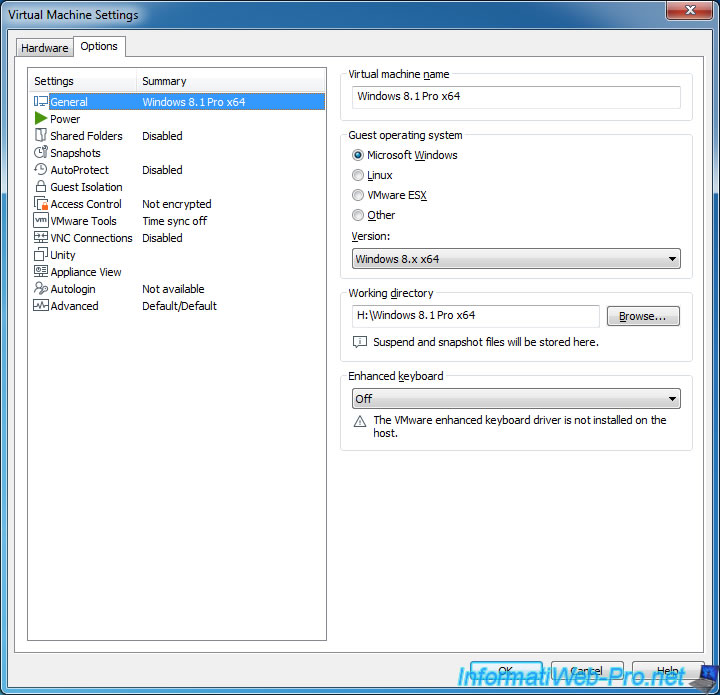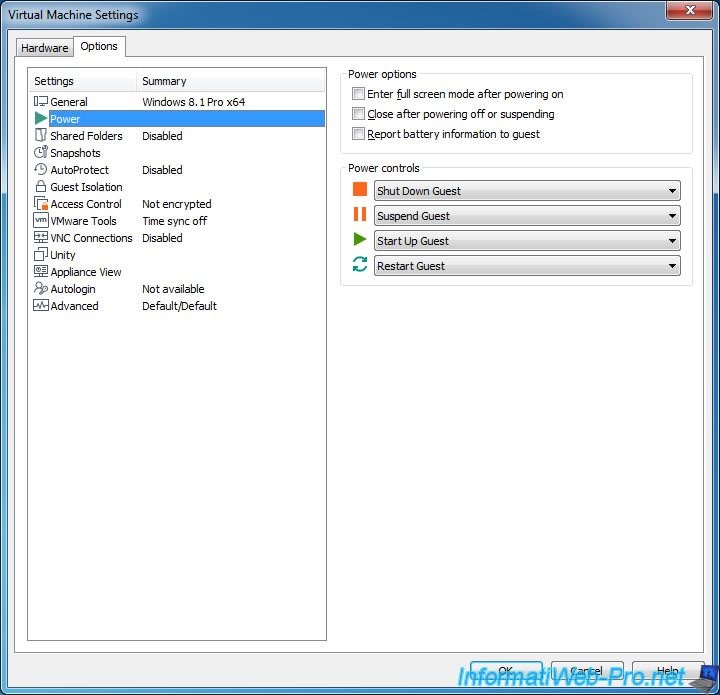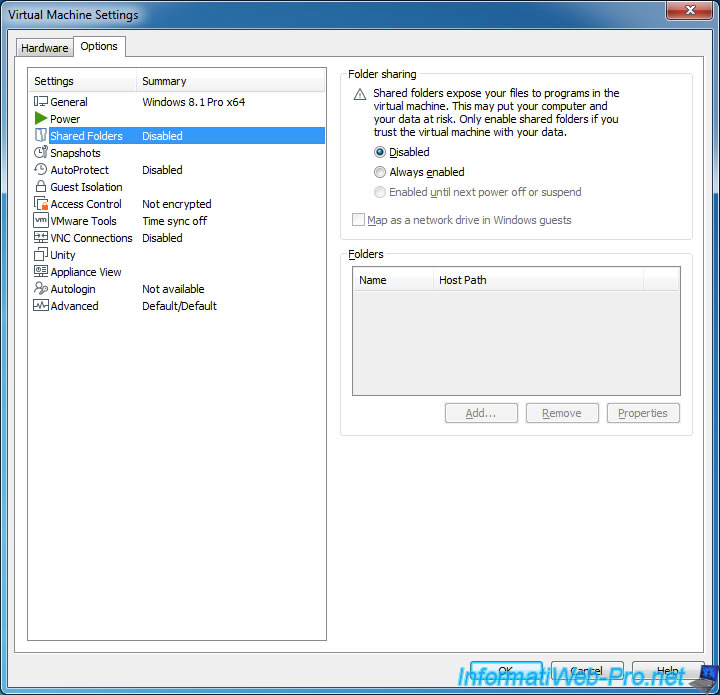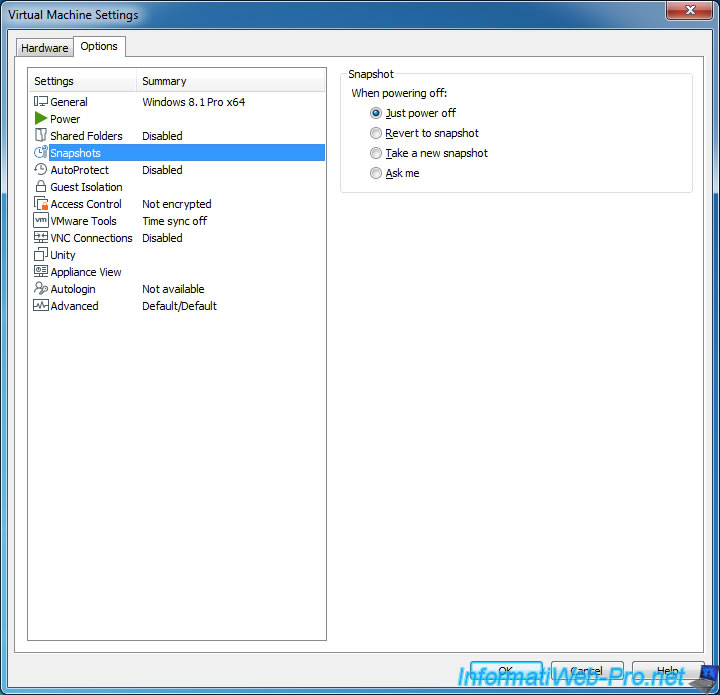Understand and configure the settings of your virtual machines with VMware Workstation 16 or 15
- VMware
- 10 July 2020 at 08:27 UTC
-

- 2/2
2. Options
2.1. General
In the General section, you will be able to :
- change the name of your virtual machine
- change the type of guest operating system (OS) : Microsoft Windows, Linux, VMware ESX or other
- change the version of the virtualized operating system
- change the storage location of the virtual machine
- use the enhanced keyboard (VMware enhanced keyboard), if you installed it during the installation of VMware Workstation

2.2. Power
In the Power section, you will find these options :
- Enter full screen mode after powering on : automatically start the virtual machine in full-screen mode
- Close after powering off or suspending : automatically close the virtual machine after stopping or pausing the virtual machine
- Report battery information to guest : communicate the battery level of the host laptop PC (if applicable) to the guest OS so that it can detect when the host PC's battery becomes low
You can also define the default action of the various power buttons (Stop, pause, ...).

2.3. Shared Folders
With VMware Tools, you can easily share folders between the host PC and the virtual machine.
For this, in the "Shared Folders" section, you will just need to activate the file sharing and add the different folders to share with this virtual machine.

2.4. Snapshots
When you use virtual machines, you also get the ability to create snapshots that allow you to restore the state of a virtual machine in a few clicks.
But, you can also automatically restore the state of it when you power off it or automatically take a snapshot of it at each power off.
For this, in the section Snapshots, you will find these options :
- Just power off : don't do anything special when shutting down the virtual machine
- Revert to snapshot : restore the state of the virtual machine to its previous state at each power off
- Take a new snapshot : take a new snapshot at each shutdown of the virtual machine
- Ask me : ask what to do

2.5. AutoProtect (automatic protection)
The AutoProtect feature allows you to automatically create snapshots periodically (every half hour, hour, or day) while retaining only the last x snapshots.
This is very convenient for development (or programming) to return to a previous version of your program or your website in case of a strange bug or accidental deletion of a piece of code for example.

2.6. Guest Isolation (guest system isolation)
By default, to make your life easier and improve the user experience, VMware Workstation allows you to drag and drop or copy/paste files or text from your host PC to the virtual machine and vice versa.
However, if you are testing not recommended or harmful programs in a virtual machine, it's best to disable these options to prevent the host operating system from being compromised by the virtual machine.
Indeed, this is a backdoor that could be used by a very clever virus.
Small novelty : from Windows 8 (host and guest), its possible to share the orientation, motion and ambient light sensors of the host tablet to the guest OS.

2.7. Access Control
In the Access Control section, you will be able to :
- encrypt your virtual machine with a password so that it can only be used with the correct password.
Without this password, the virtual hard disk and the configuration files of it will no longer be readable directly from the file explorer. - restrict access to virtual machine settings with the same password or a different password
- allow the connection of USB devices to this virtual machine or not
- program the automatic expiration of this virtual machine if you wish
Warning : as indicated on the "VMware Workstation 16 Pro Release Notes" page of the VMware site, the restrictions that you could set on virtual machines are no longer available since version 16 of VMware Workstation.

2.8. VMware Tools
With the installation of VMware Tools in the guest operating system, you will be able to :
- enable synchronization of the time of the guest OS with that of the host PC
- enable or disable the automatic update of VMware Toos in the guest OS

2.9. VNC Connections
As you can see, VMware virtual machines can also be remotely controlled through a classic VNC client.
Although this requires some extra manipulations if you speak a language other than English.
Otherwise, the keyboard used by VMware will probably not be the right one.
For more informations about this feature, refer to our tutorial : VMware Workstation - Remotely access to a VMware Workstation virtual machine over VNC

2.10. Unity
Unity is a very nice feature that allows you to use applications installed in the guest OS as if it were an application installed on the host PC.
This is very useful if you want to use 2 programs simultaneously and one of them only works on another operating system than the one installed on the host PC.
With this feature, you will feel that these two programs work on your host PC, even if one of the two is obviously virtualized.

2.11. Appliance View
The Appliance View option is only useful when you are (legally) distributing a virtual machine over the Internet, so you want to add your name as author and a version (if needed).
For the "Access port inside virtual machine" option, it simply serves to add a "View appliance management page" link on the summary of the virtual machine that will redirect to a management's page of the virtual machine (if a web server is installed into it and that it's accessible from any machine on the network).
In our case, we have this as Appliance Details :
- Version : 1.0
- Author : InformatiWeb
And we checked the "Access port inside virtual machine: 80" box.

In this virtual machine, we installed a simple web server with Apache, PHP and MySQL.
Note that port 80 (HTTP) is allowed in the firewall of this virtual machine.

Then, start the virtual machine and here is what it gives.

2.12. Autologin
When you install Windows as a guest operating system and your account is not password protected, by default, Windows automatically enters this session.
However, if you have protected it with a password, then you will have to retype it each time you launch this virtual machine.
To avoid this, VMware provide the Autologin feature that allows you to log in automatically with a password-protected account (in the guest OS) without having to type it each time you start it.
Note, however, that you can only log in with a local account.
So, you will not be able to use this feature to log on in a virtual machine with an Active Directory account.
Important : VMware Tools must of course be installed in the guest OS so that you can use this feature.

2.13. Advanced
Finally, in the advanced settings of your virtual machine, you will find several settings for the experts.
To begin, you will be able to manage the process priorities :
- Input grabbed : when you use the virtual machine
- Input ungrabbed : when the virtual machine is running in the background
Depending on this state, you will be able to ensure that the VM processes are prioritized over host machine processes or vice versa. In general, you will never change these settings.
For the Settings part, you will find these options :
- Gather debugging information : enable the creation of debug information or statistics to find the solution to a problem that would occur with this virtual machine.
- Disable memory page trimming : the "memory page trimming" is a technique that VMware uses to restore memory that your virtual machine doesn't use to the host PC and may be necessary if you don't have a lot of RAM in the host PC
- Log virtual machine progress periodically : if this option is enabled, VMware Workstation will save informations about the virtual processor, instruction pointers, ... in the log file. This can be useful for debugging or for improving the performance of your virtual machine
- Enable Template mode : allows you to define a virtual machine as a template and prevent it from being accidentally deleted. This accidental deletion would permanently prevent the clones linked to it from functioning.
- Gather verbose USB debugging information : enable USB debug information creation (if "Gather debugging information" option is also enabled)
- Clean up disks after shutting down this virtual machine : automatically cleans the virtual hard disks associated with your virtual machine every time it's shut down to automatically delete the deleted data in your virtual machine and avoid loose unnecessary space on the physical hard disk of the host PC.
Nevertheless, this process can take a long time.
For the type of firmware, it depends on the guest OS and its change is strongly discouraged once the guest OS is installed.
Indeed, the installation of Windows is different depending on whether the EFI firmware was used or not.
Nevertheless, here is what these options mean :
- BIOS : use of a classic BIOS (Phoenix BIOS) compatible with all operating systems
- UEFI : new firmware implemented in the recent motherboards and allows you to benefit from the secure booting supported since Windows 8.
In addition, installation in EFI of Windows 8 or later will cause the use of a GPT partition table instead of the conventional MBR for the hard drive where Windows will be installed. - Enable secure boot : allows you to use the secure boot supported by Windows 8 and later (requires UEFI firmware for the virtual machine)
Finally, you will find the locations of the configuration and log file of the virtual machine.

Share this tutorial
To see also
-

VMware 3/16/2013
VMware Workstation - Boot a VM on the BIOS / EFI firmware
-

VMware 2/7/2020
VMware Workstation 15 - Installation on Linux
-

VMware 12/24/2021
VMware Workstation 15 - Slice the virtual hard disk of a VM
-

VMware 12/10/2021
VMware Workstation 15.5 - Convert a Virtual PC virtual machine to a VMware VM

No comment